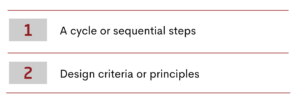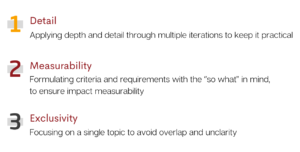5 minute read
Takeaway: While it requires more effort up front, setting design criteria from the beginning helps to speed up implementation at the end. Design criteria guide the entire redesign, strategic direction, and parameters, augmenting alignment and adding clarity throughout the process. Yet, a set of vague and immeasurable criteria won’t cut it…
Approaching any design project can feel daunting. An important aspect to consider when redesigning a business is whether your organisation needs/is ready for a proper haircut… or only wants a trim. Principles, trade-offs, dilemmas, criteria, parameters: these are terms used as a form of guidance for informed and thorough design decisions. If the design decisions are aligned, the outcomes differentiate the organisation with a significant competitive advantage.
Developing Design Criteria
Formulating and deciding on design criteria can present its own challenges. This can result in criteria that are too vague or say the same thing in different terms. Another common issue is ignored or forgotten design criteria.
That leaves us with the question: what’s the point of developing criteria if they aren’t helpful throughout the process? I’ve worked at numerous consulting firms and seen different organisation design methodologies. It’s common for methodologies to include: 
Design Criteria Guides Design Decisions
What really differentiates OTM’s methodology is the foundation for consistent and essential design decisions. These decisions must meet these three criteria:
Even though it can be challenging and take longer, these three factors are the most important. They set the foundation of all the work and decisions to come. And I have seen what dangerous rabbit holes that design teams easily get trapped into when the criteria don’t meet a certain level of detail. Additionally, the timing is a key condition to setting these foundational requirements. It is best to do so at an early stage, to preserve the most objective state as possible.
However, not even the most purist and measurable design criteria will guide a group into making robust design decisions.
Throughout my years of external consulting, I’ve witnessed firsthand the different degrees to which the org design art can be practiced and brought to life.
It’s a lot of work upfront but accelerates the design steps ahead.
At OTM, we intentionally spend more time and effort during the initial phases, such as current state review. The greater time and effort exerted upfront enables implementation to move more quickly once other decisions fall into place. A meager and less detailed foundational base may result in a regression, sweeping back into what is familiar. That would be a trim, not a proper and needed haircut.
Let’s Talk!
Anissa Oukhiar is a Consultant at ON THE MARK. OTM is a global leader in collaborative operating model modernization that creates real change, fast. OTM’s passion for collaborative business transformation is supported by pragmatism, systems thinking, and a belief in people that is unparalleled for 33 years.






